
By Karen Rubin, Travel Features Syndicate, goingplacesfarandnear.com
No exhibit that looks back into the past has been more timely and relevant than “Notorious RBG” which recently opened at the New-York Historical Society – a homage to the trailblazing Supreme Court justice, lawyer, wife, mother and woman, Ruth Bader Ginsburg, who at age 80, became an internet phenomenon and cultural icon. It is so important to be reminded – through her words, documents, historical artifacts, archival photographs, contemporary art and interactives – of what society was like, what it took to change, and what is at risk today. The SCOTUS with the mostus challenged us to continue her work for a just, equal and compassionate society.
The traveling exhibit, which was organized by the Skirball Cultural Center in Los Angeles and based largely on Irin Carmon and Shana Knizhnik’s book, “Notorious RBG: The Life and Times of Ruth Bader Ginsburg” (which was the source for a documentary), opened to the public just the day before marches in Washington DC and around the nation in support of women’s reproductive rights. It was also mere days before the start of the Supreme Court’s new term, with a 6-3 conservative majority, including the justice who took her seat, Amy Coney Barrett, gunning to overturn the landmark 1973 Roe v. Wade decision. “Notorious RBG” is on display only through January 23, 2022.
“It is different to be here, knowing she’s not with us,” author Irin Carmon reflected at the press preview of the exhibit. “She intended to visit Skirball but cancelled because of her cancer treatment. When the exhibit came to Philadelphia, she agreed to accept an award and see it more than a year after opened. It was an extraordinary experience of giving her a tour of her life.”
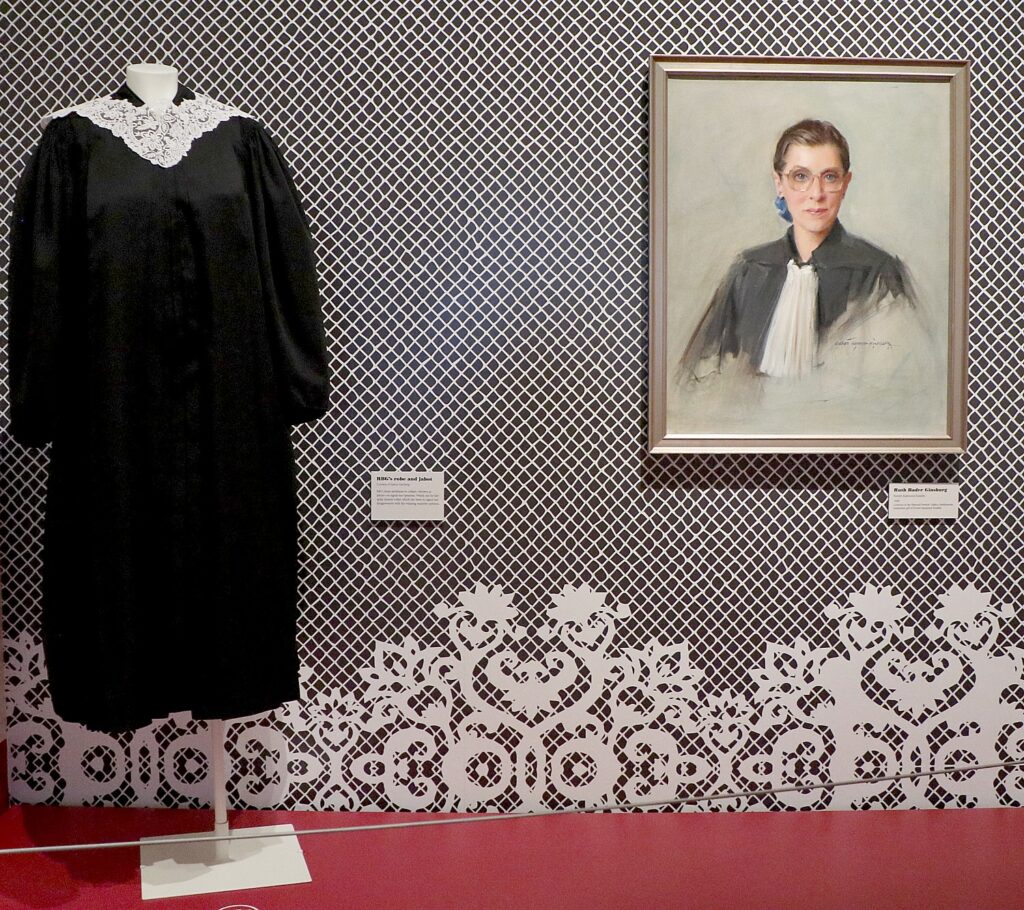
“We walked her through to an imagined re-creation of her childhood living room. She stopped, as if completely alone, stopped in front of a portrait of her mother – who died just before her high school graduation. Opera was playing on an old fashioned radio. We all fell silent as she gazed. I thought of what she said when she accepted the nomination to the Supreme Court in 1993, standing with President Clinton. I was thinking what her mother would have thought.”
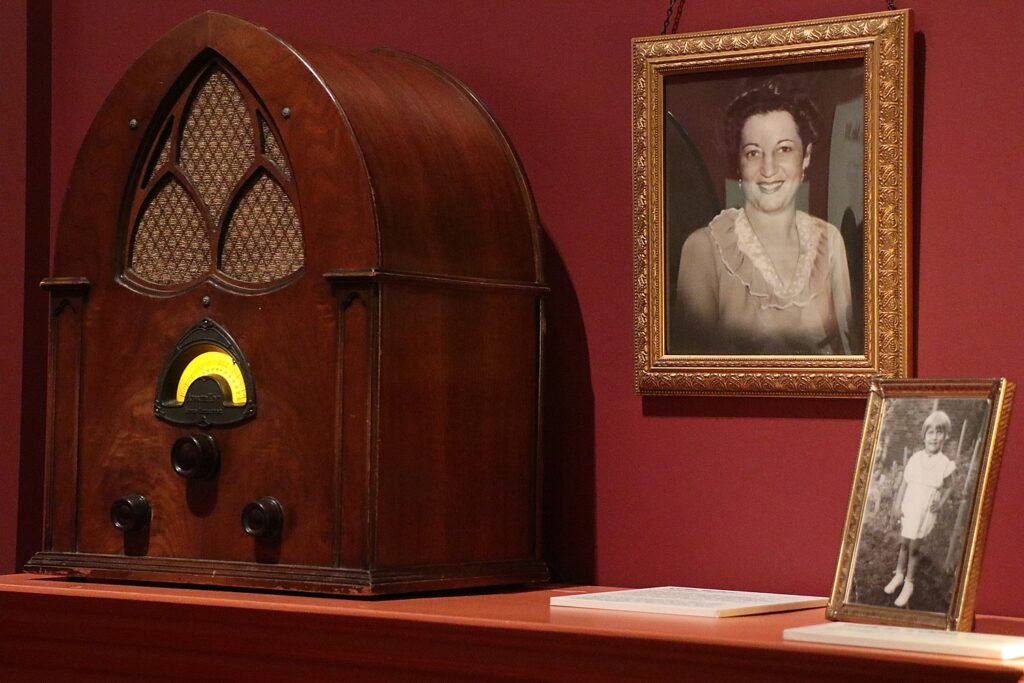
What RBG said on that day was, “It is to my mother, Celia Amster Bader, the bravest and strongest person I have known, who was taken from me much too soon. I pray that I may be all that she would have been had she lived in an age when women could aspire and achieve and daughters are cherished as much as sons.”
Justice Ginsburg said she would have come to the NYHS’ exhibit, which was supposed to open in 2020, but the exhibit was delayed because of COVID. She died September 18, 2020.
“It falls on all of us who share her values, what she stood for, to carry on her legacy,” Carmon said.
The exhibit traces her life from modest beginnings in Brooklyn, losing an older sister when she was two, her mother sick with cancer from when she was 13 and dying just before her high school graduation.
But you appreciate how Brooklyn was formative to the person she became – the immigrant community of Eastern Europeans, Irish and Italians. Her Jewish heritage inbued in her a commitment to seek justice and compassion, to question, and it triggered her feminism when, in Jewish tradition, she was not counted in the minyan (the quorum of 10 males required) at her own mother’s funeral because she was female.
RBG became “notorious” because of her firey dissent in Shelby v Holder in 2013, when the majority overturned the preclearance requirement in the Voting Rights Act, unleashing a score of voter discrimination laws in states that otherwise would have been curtailed. She charged that overturning the Voting Rights Act would invite violations of the 15th amendment. The decision was 5-4, with Chief Justice Roberts saying it wasn’t needed anymore because (after Obama’s election to the presidency) “things changed.”
In her dissent, RBG said that overturning the provision was like “throwing away your umbrella in a rainstorm because you are not getting wet.”
We enter the exhibit at the pinnacle – one of her Supreme Court robes and jabots on display, an official portrait of her in her office as only the second woman to have served on the Supreme Court, a PBS News Hour video of her as “Notorious RBG”, and as you wind through, you understand the context, the ecosystem, that forged her character and set her on her path.
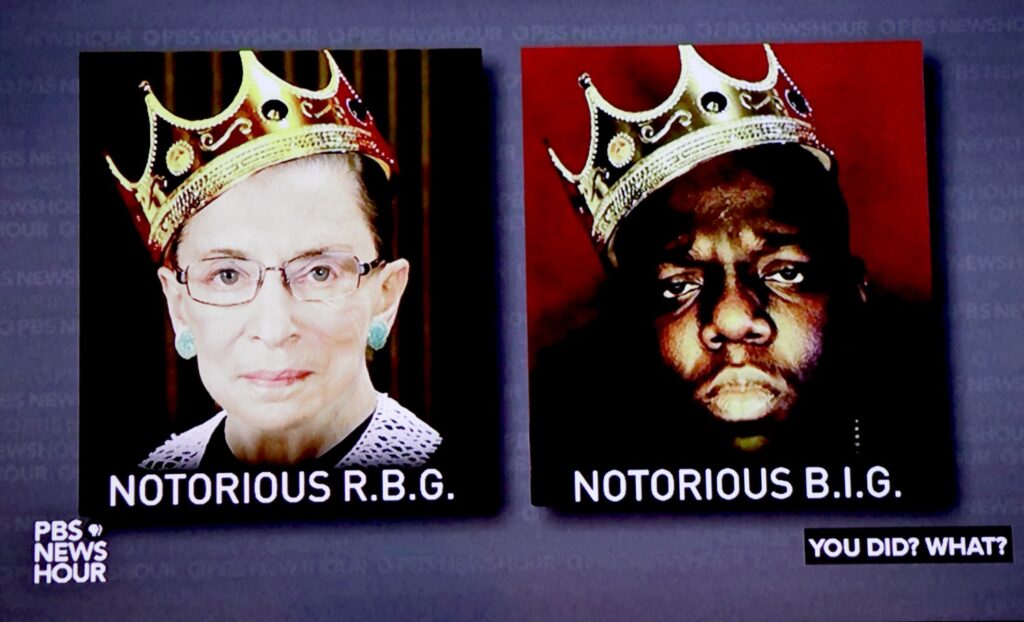
She took the “Notorious RBG” with humor – in a video of a PBS News Hour appearance, she said, “Notorious B.I.G. and I have something in common – we are both from Brooklyn.”
Very quickly, we are pushed back in time to her childhood in Flatbush Brooklyn, her time at Cornell University where she met Martin Ginsburg, and their decision to pursue law – because she thought lawyers the vanguard of societal change and because Harvard Law School had begun to accept women, albeit precious few.
“Both wanted to marry and keep on working together…Harvard Business School did not accept women. So they settled on law.”
From the beginning, “Their marriage defied gender expectations of the period and embodied her belief that men, women, and families are better when both partners share their lives and goals on equal footing. Marty was a passionate supporter of his life partners’ legal career and shared in child rearing and household responsibilities long before men were expected to do so.”
When Marty got sick with testicular cancer, she took his notes and transcribed his papers so he could stay in the program. And she left Harvard Law to go to Columbia when Marty got a job in New York (she made the Law Review at both.)
When she graduated, no law firm would hire her – “I was Jewish, a mother and a woman” so three strikes against her. She began teaching at Rutgers.
She signed up as a volunteer lawyer at the New Jersey branch of the American Civil Liberties Union, which was being overwhelmed by letters from women. “None of their problems were new. What was new was that anyone thought it was worth complaining about.”
“It was clear to RBG that fighting discrimination one strongly worded letter at a time was like catching the ocean in a thimble. There would always be another sexist law or regulation to take down. Women’s rights advocates needed to think bigger. What the country needed was a broader recognition of gender equality.”
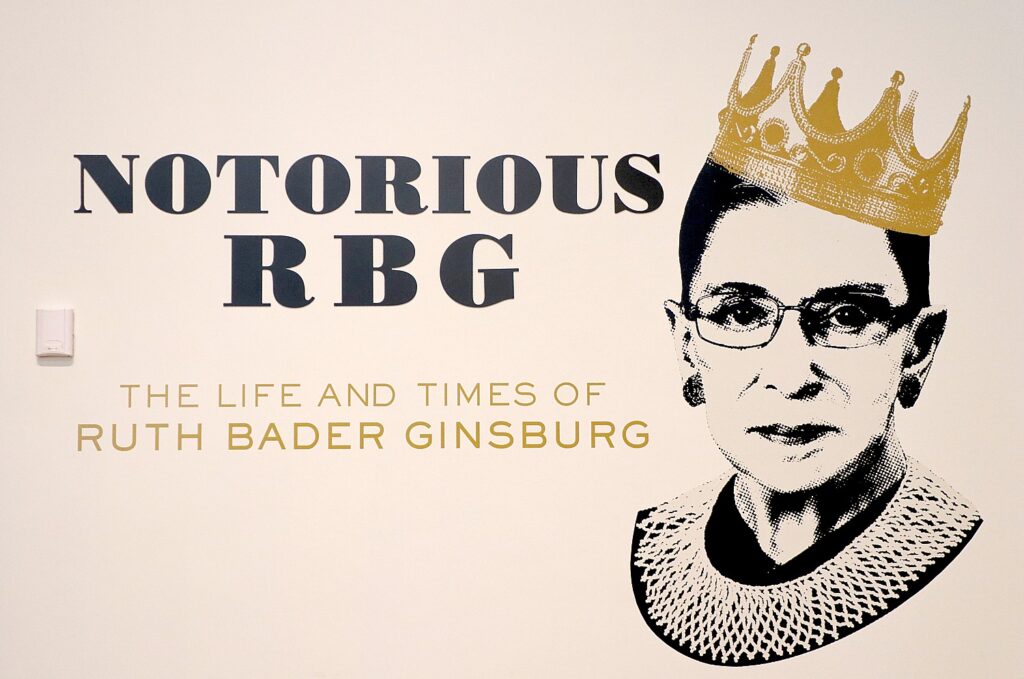
There is a very illuminating list of what women couldn’t do in the 1930s and 1940s – a sort of marker – which women today take for granted:
Practice law in most states or become a judge
Serve on a jury in most states
Get paid the same amount as men for doing the same work
Answer want ads for jobs labeled “men only”
Open a bank account or get a credit card without a husband’s or male relative’s permission (I would add: get a mortgage or a business loan without a man to co-sign)
In some states, own property without having a husband in control as “head and master”
Attend most Ivy League universities
Play school sports on an equal basis with boys
Attend a military academy
Get pregnant without the threat of losing her job
Wear pants on the US Senate floor
Serve in combat in the military
Much of her argument for gender equality was derived from the 14th Amendment – passed after the Civil War’s emancipation of slaves: “No State shall make or enforce any law which shall abridge the privileges or immunities of citizens of the United States; nor shall any State deprive any person of life, liberty, or property, without due process of law; nor deny to any person within its jurisdiction the equal protection of the laws.” (Roe v. Wade was decided based on the “right to privacy” implied by “due process” rather than “equal protection”.)
Marty, a prominent tax attorney, brought her the breakthrough case, Moritz v. Commissioner of Internal Revenue. Charles Mortiz was a businessman who was caring for his 89-year old mother, but the IRS denied him the tax deduction for expenses for her care that was allowed women, widowers or husbands of incapacitated women. But Moritz had never married. “The idea that a man might be a caregiver had apparently never crossed the government’s mind,” Ginsburg wrote.
The Ginsburgs realized that the government was senselessly denying a benefit to someone purely on the basis of sex. “If the court said that was wrong, the precedent would open the door to a broader recognition of gender equality.”
“The line the law drew rested on a stereotype: Women are caregivers, so a daughter would take care of her aging mother but men are out in the world, earning a living, so they don’t take personal care of aging parents. That law was blind to the life Charles E. Moritz lived. We took his case from the tax court to the Tenth Circuit. Marty argued the tax part of it and I argued the equal protection part,” RBG wrote.
And when one of her cases brought her up against her former Harvard Dean Erwin Griswold, who had become Solicitor General of the US, he had counsel prepare an appendix of all the laws that would have to be changed if Ginsburg were successful in her argument about gender discrimination in the law. In other words, you change this law, you have to change all the others. Ruth saw it as a handy roadmap.
Between 1971 and 1981, RBG litigated cases that would set the stage for gender equality (or rather, “neutrality”): widower, pregnancy, forced sterilization of black women; jury, and even the right to buy beer at age 18.
It is important to note in these times as a woman’s reproductive freedom is in question, that the government that can ban abortion – and deny a woman’s right to autonomy over her own body – is also a government that can force sterilization, or require an abortion. This is exactly what the government did to Captain Susan Struck in 1970; the case that RBG took up, Struck v. Secretary of Defense, resulted in the USAF changing its policy of automatically discharging pregnant women who refused to get an abortion, and led to Congress passing the Pregnancy Discrimination Act of 1978.
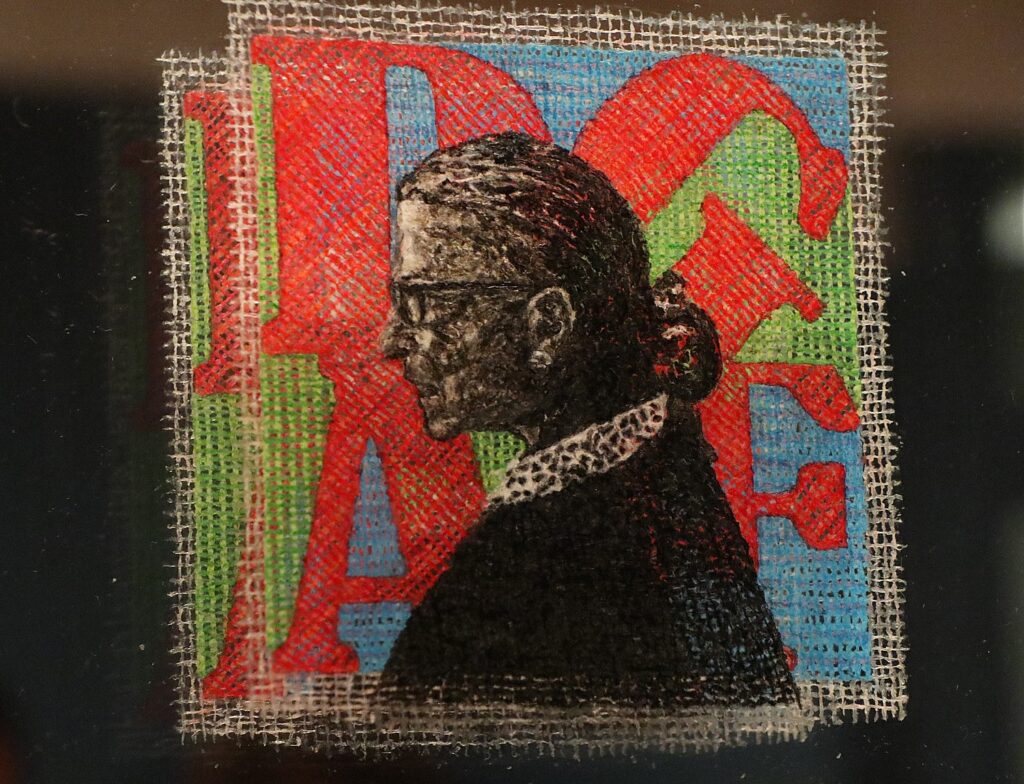
RBG spearheaded the formation of the Women’s Rights Project at the ACLU to tackle discrimination in education and training programs, prisons and the military, advocate for reproductive freedom and hold accountable institutions that discriminated against pregnant women.
You can listen in on decisions and see original documents and artifacts – for example, Stephen Wisenfeld’s letter to the editor complaining of the discriminatory rule of Social Security that prevented him from getting survivor’s benefits after his wife, the “breadwinner” of his family, died in childbirth; the personal letter from RBG to Stephen Wisenfeld in 1977 about going to DisneyWorld, which is so revealing about her as a person; photos of RBG with Steven’s son Jason Wiesenfeld when she officiated at Jason’s wedding in 1998, and another with Stephen Wiesenfeld and Elaine Harris Wiesenfeld at their 2014 wedding that RBG officiated.
“Wiesenfeld is part of an evolution toward a policy of neutrality – a policy that will accommodate traditional patterns, but at the same time, one that requires removal of artificial constraints so that men and women willing to explore their full potential as humans may create new traditions by their actions.” RBG wrote (she won an 8-0 decision at the Supreme Court).
The 2016 anti-abortion case, Whole Woman’s Health v. Hellerstedt, 2016, struck down a Texas law that required such stringent standards on abortion clinics that they would have had to be shut down. The court ruled 5-3 that this imposed an “undue burden.”
RBG joined Stephen Breyer in his majority opinion but added, “I fully subscribed to everything Breyer said, but it was long and I wanted something pithy…. I wrote to say, ‘Don’t try this anymore.’”
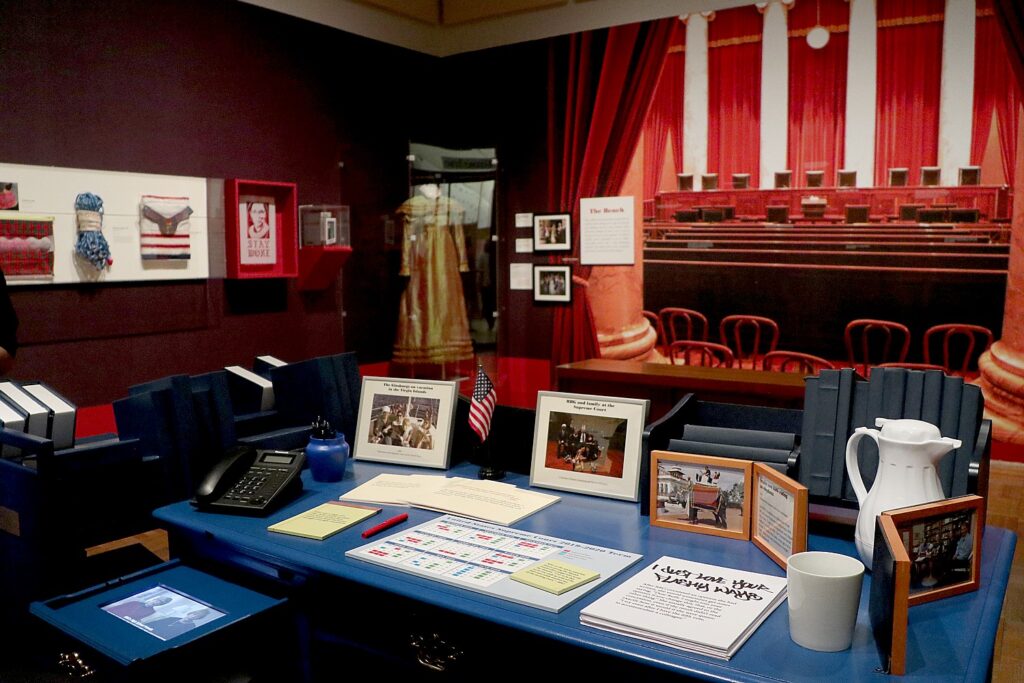
But we know that they have not stopped trying to chip away at the “undue burden” standard. Now Texas has come up with most brazen assault on women’s rights, without Ginsburg on the bench to challenge, instead, replaced by an ultra-conservative, anti-abortion justice Amy Coney Barrett. In a dire sign of what is to come, the court allowed the Texas law to go into effect – creating a new class of vigilantes and bounty hunters to enforce a blatantly unconstitutional “burden” on women who seek an abortion after six-weeks.
RBG’s last dissent was in 2020, in the “Little Sisters of the Poor v Pennsylvania,” in which the majority, 7-2 allowed religious objectors to be exempted from the Affordable Care Act’s regulatory requirement to provide health plans that include contraceptive coverage.
“Today, for the first time, the Court casts totally aside countervailing rights and interests in its zeal to secure religious rights to the nth degree,” she wrote.
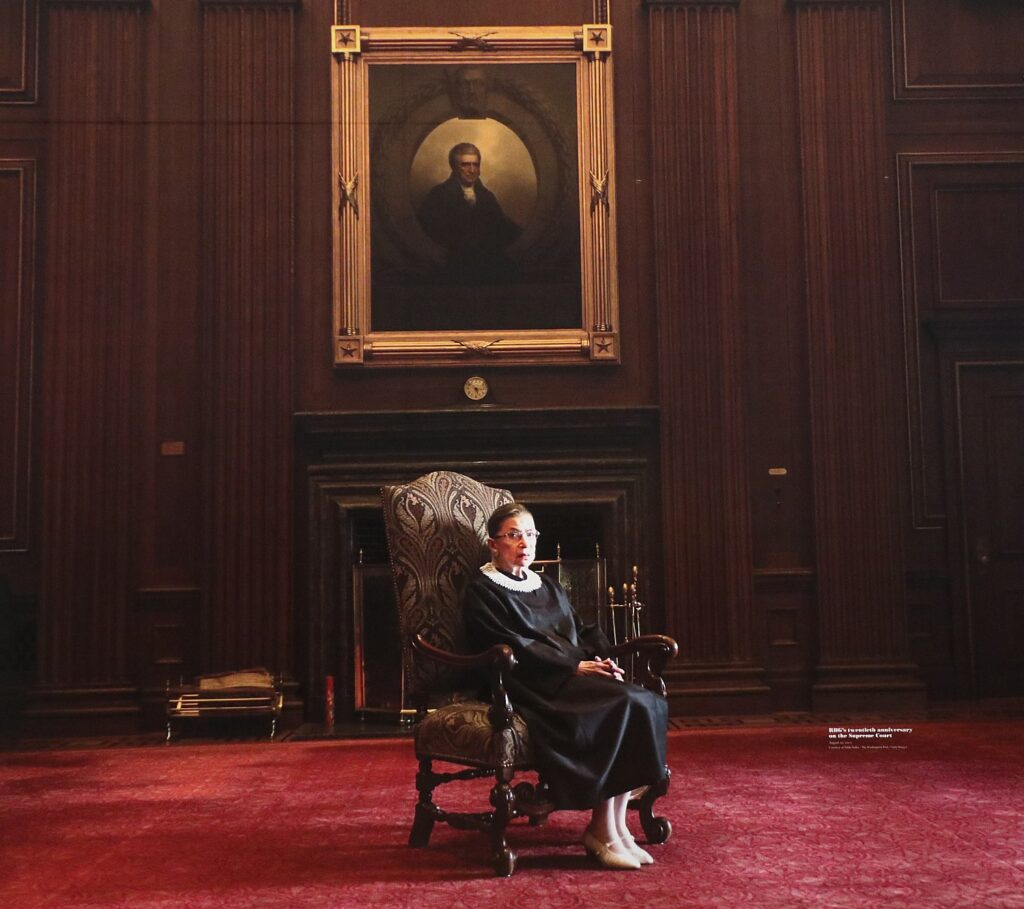
On her deathbed, Justice Ginsburg told her granddaughter Clara Spera, “My most fervent wish is that I will not be replaced until a new president is installed.”
But Majority Leader Mitch McConnell could care less, and even though the 2020 presidential election had already gotten underway (and he had delayed an Obama nomination more than a year, to give Trump his appointee, Neil Gorsuch in place of Merrick Garland), pushed through his candidate, Amy Coney Barrett to complete a 6-3 radically conservative majority on the court.
And so, people are marching, rallying and protesting again with urgency to protect the rights that were thought to have been won, but now may be overturned. Many carry a sign that reads, “Ruth sent me.”

There are such personal items, including a reproduction of the letter her husband Marty wrote just before he died, in 2010, “My dearest Ruth- You are the only person I have loved in my life…what a treat it has been to watch you progress to the very top of the legal world!!”
Personal materials range from home movies of RBG with Marty on their honeymoon and in the early years of their marriage to yearbooks from RBG’s academic life—from her Brooklyn high school to Harvard, Columbia, and Rutgers Universities—to a paper that she wrote as an eighth grader exploring the relationship between the Ten Commandments, the Magna Carta, the Bill of Rights, the Declaration of Independence, and the recently formed United Nations Charter, and the costume she wore for her cameo as the Duchess in Washington National Opera’s production of “Daughter of the Regiment.”
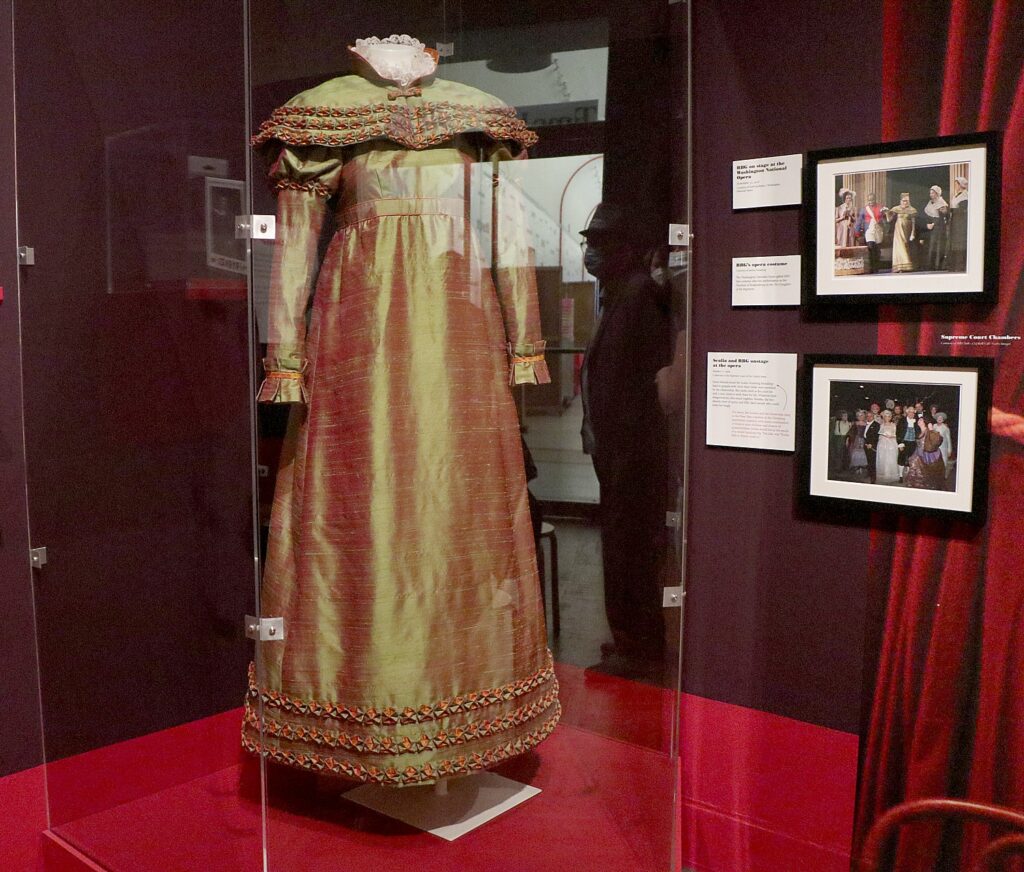
Special to New-York Historical’s presentation – and only seen here – are remembrances from RBG’s visit to the museum in 2018 to officiate a naturalization ceremony of 200 new citizens after she learned about New-York Historical’s Citizenship Project which teaches U.S. history and civics to green card holders. (She sent a note, “I had shingles, not yet diagnosed, on April 10, but would not have missed the oath-taking ceremony. Looking out at the 201 faces of the new citizens, I could hardly hold back the tears. The diversity represented among the new citizens, proudly pledging allegiance, is what the USA means to me. With appreciation, Ruth Bader Ginsburg.”

There is also a video featuring a map and photographs of key places in her life as a New Yorker, and an overview of the memorials that cropped up around her hometown in the wake of her passing, “Rest in Power, A City Mourns Its Own.”
The various RBG iconography on display is fun and fascinating, like the “real life action figure” (you can buy one in the gift shop).
The strangest – and one of the most personal – is the “RBG Tattoo II” by Ari Richter, fashioned of pigmented human skin on glass, painted with a photo of RBG taken as she officiated at the artist’s wedding to “Notorious RBG” author Irin Carmon.
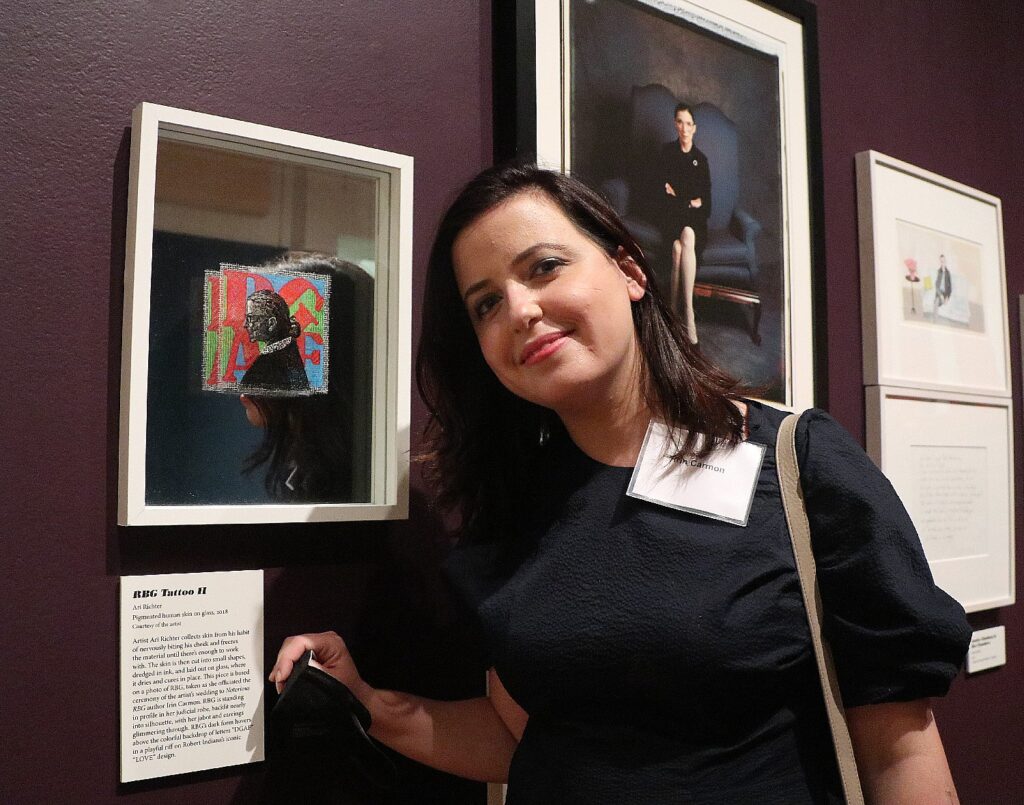
When Irin Carmon asked, “And when the time comes, what would you like to be remembered for?” RBG replied, “Someone who used whatever talent she had to do her work to the very best of her ability. And to help repair tears in her society, to make things a little better through the use of whatever ability she has.”
As part of New-York Historical’s upcoming public program series, on December 8, Supreme Court expert Linda Greenhouse looks at where the courts stand following Justice Ginsburg’s death. Families can explore the exhibition with a specially created family guide, and themed story times will take place throughout the exhibition’s run.
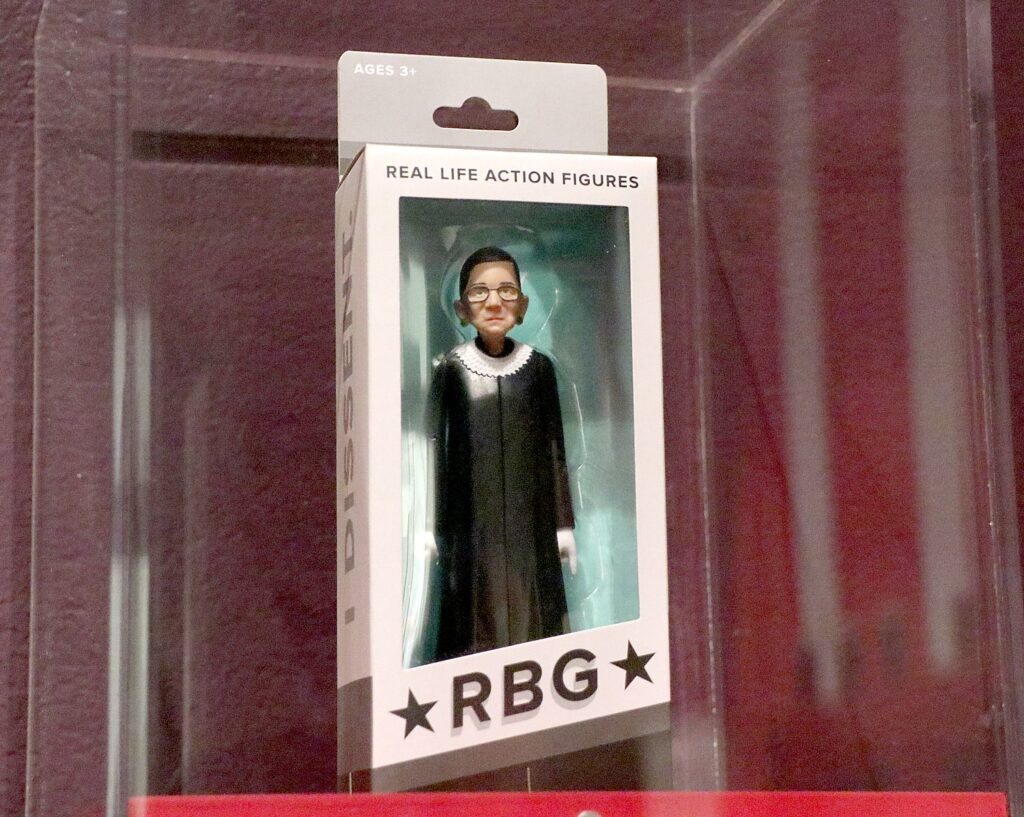
After debuting at the Skirball Cultural Center in 2018, Notorious RBG: The Life and Times of Ruth Bader Ginsburg has toured the country. After its New York run, the exhibition will travel to the Holocaust Museum in Houston (March 2022) and the Capital Jewish Museum in Washington, D.C. (September 2022).
Notorious RBG: The Life and Times of Ruth Bader Ginsburg has been coordinated at New-York Historical by Valerie Paley, senior vice president and Sue Ann Weinberg Director, Patricia D. Klingenstein Library; Laura Mogulescu, curator of women’s history collections; and Anna Danziger Halperin, Andrew W. Mellon Postdoctoral Fellow in Women’s History and Public History, Center for Women’s History.
The New-York Historical Society, 170 Central Park West (77th Street), New York, NY 10024, 212-873-3400, nyhistory.org. Follow the museum on social media at @nyhistory on Facebook, Twitter, Instagram, YouTube and Tumblr.
______________________
© 2021 Travel Features Syndicate, a division of Workstyles, Inc. All rights reserved. Visit goingplacesfarandnear.com, www.huffingtonpost.com/author/karen-rubin, and travelwritersmagazine.com/TravelFeaturesSyndicate/. Blogging at goingplacesnearandfar.wordpress.com and moralcompasstravel.info. Send comments or questions to [email protected]. Tweet @TravelFeatures. ‘Like’ us at facebook.com/NewsPhotoFeatures

